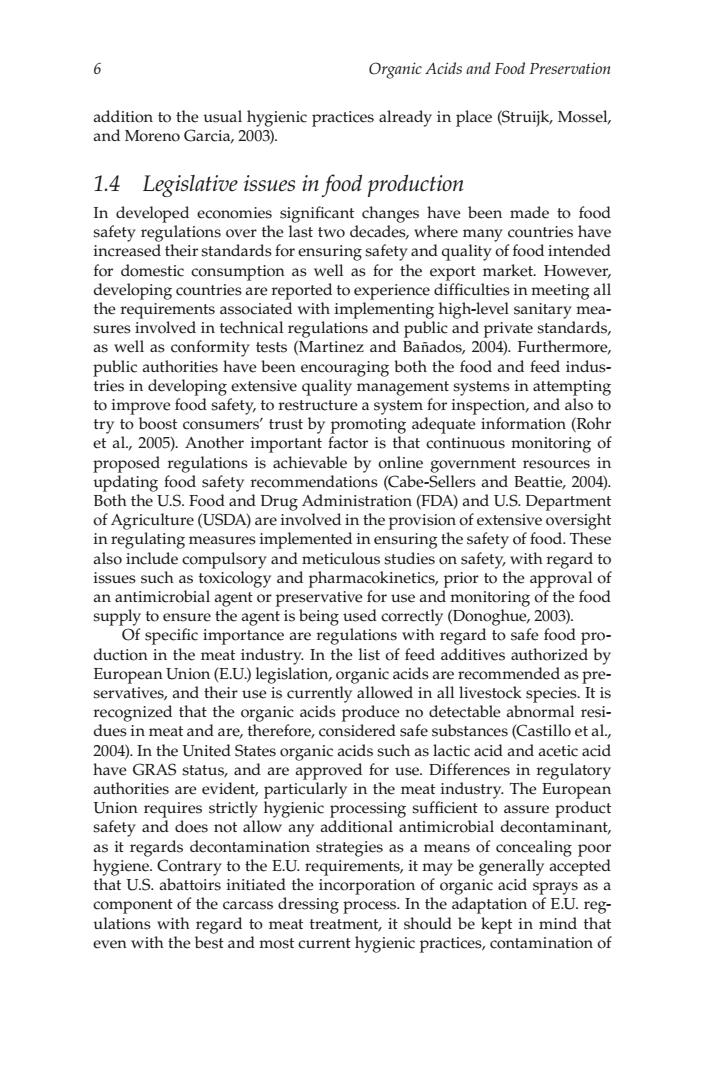正在加载图片...

Organic Acids and Food Preservation 1.4 Legislative issues in food production In developed economies significant changes have been made to food safety regulations over the last two decades,where many countries have increased their standards for ensuring safety and quality of food intended for domestic consumption as well as for the export market.However, developing countries are reported to experience difficulties in meeting all the requirements associated with implementing high-level sanitary mea- sures involved in technical regulations and public and private standards, as well as conformity tests (Martinez and Banados,2004).Furthermore bee raging both the food and feed inc sivequality managemer in att tety, ucture a system for inspe try to consumer trust by promo ing adequ ate etal,005)Another important nformat on (Rohr actor is that continuous monitoring of proposed regulations is achievable by online government resources in updating food safety recommendations (Cabe-Sellers and Beattie,2004) Both the U.S.Food and Drug Administration(FDA)and U.S.Department of Agriculture(USDA)are involved in the provision of extensive oversight in regulating measures implemented in ensuring the safety of food.These also include compulsory and meticulous studies on safety.with regard to issues such as toxicology and pharmacokinetics,prior to the approval of spe cific i are r ulation ith ard to safe food of feed addiives autho European Uni n(E.U)legislation,o by rga nic a recom eir use is currently allowed in all lives ended as pre servatives,and th speci It is recognized that the organic acids produce no detectable abnormal res dues in meat and are,therefore,considered safe substances(Castillo et al 2004).In the United States organic acids such as lactic acid and acetic acid have GRAS status,and are approved for use.Differences in regulatory authorities are evident,particularly in the meat industry.The European Union requires strictly hygienic processing sufficient to assure product safety and does not allow any additional antimicrobial decontaminant, as it regards decontamination strategies as a means of concealing poor ary to the E.U.requireme nts,it ay be sen rally accep nitiated the the with sing proc the ohrays as a regard to meat treatment,it should be kept in mind tha even with the best and most current hygienic practices,contamination of6 Organic Acids and Food Preservation addition to the usual hygienic practices already in place (Struijk, Mossel, and Moreno Garcia, 2003). 1.4 Legislative issues in food production In developed economies significant changes have been made to food safety regulations over the last two decades, where many countries have increased their standards for ensuring safety and quality of food intended for domestic consumption as well as for the export market. However, developing countries are reported to experience difficulties in meeting all the requirements associated with implementing high-level sanitary measures involved in technical regulations and public and private standards, as well as conformity tests (Martinez and Bañados, 2004). Furthermore, public authorities have been encouraging both the food and feed industries in developing extensive quality management systems in attempting to improve food safety, to restructure a system for inspection, and also to try to boost consumers’ trust by promoting adequate information (Rohr et al., 2005). Another important factor is that continuous monitoring of proposed regulations is achievable by online government resources in updating food safety recommendations (Cabe-Sellers and Beattie, 2004). Both the U.S. Food and Drug Administration (FDA) and U.S. Department of Agriculture (USDA) are involved in the provision of extensive oversight in regulating measures implemented in ensuring the safety of food. These also include compulsory and meticulous studies on safety, with regard to issues such as toxicology and pharmacokinetics, prior to the approval of an antimicrobial agent or preservative for use and monitoring of the food supply to ensure the agent is being used correctly (Donoghue, 2003). Of specific importance are regulations with regard to safe food production in the meat industry. In the list of feed additives authorized by European Union (E.U.) legislation, organic acids are recommended as preservatives, and their use is currently allowed in all livestock species. It is recognized that the organic acids produce no detectable abnormal residues in meat and are, therefore, considered safe substances (Castillo et al., 2004). In the United States organic acids such as lactic acid and acetic acid have GRAS status, and are approved for use. Differences in regulatory authorities are evident, particularly in the meat industry. The European Union requires strictly hygienic processing sufficient to assure product safety and does not allow any additional antimicrobial decontaminant, as it regards decontamination strategies as a means of concealing poor hygiene. Contrary to the E.U. requirements, it may be generally accepted that U.S. abattoirs initiated the incorporation of organic acid sprays as a component of the carcass dressing process. In the adaptation of E.U. regulations with regard to meat treatment, it should be kept in mind that even with the best and most current hygienic practices, contamination of